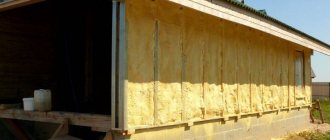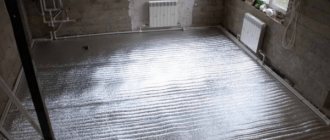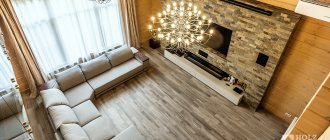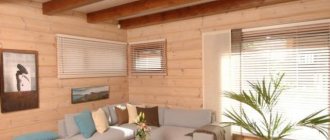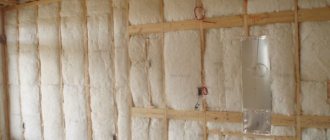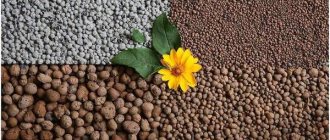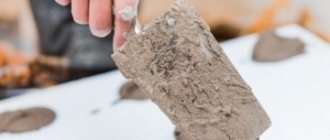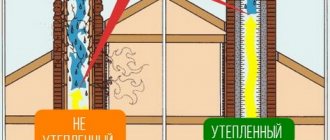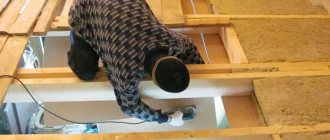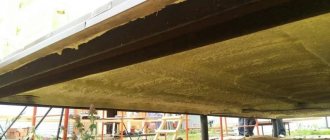Residents of private houses often get very cold in winter. After all, heat escapes through windows and doorways, cracks in the floor, as well as walls. To solve this problem, mineral wool for insulating the ceiling helps a lot.
Below in the article a video of do-it-yourself ceiling insulation with mineral wool is published, as well as the main nuances of installing this building material.
Features of ceiling insulation with mineral wool
Mineral wool is considered a good ceiling insulation. This building material covers the attic area or living space.
Mineral wool is made from the following materials:
- cullet;
- sand;
- blast furnace slag;
- rocks (basalt).
Mineral wool is considered the most popular building material for ceiling insulation. You can insulate the ceiling in a wooden house with the following mineral wool:
- slag;
- glass wool;
- basalt (stone) wool.
Attention!
All insulating building materials made from mineral wool have one big drawback. In their production, phenol-formaldehyde resin is used. Therefore, when using insulation, this building material emits substances harmful to humans. As a result, mineral wool often worsens the health of residents of a private house. However, many homeowners still use mineral wool as ceiling insulation. After all, this mineral building material has various advantages and has few disadvantages compared to its analogues.
Foil slabs made of mineral wool of the smallest thickness take up little space in a living room and provide good thermal insulation. Fire-resistant mineral wool reflects the heat going outside back into the room.
If there is an unheated cold attic in a cottage or private house, then a thick layer of mineral wool is needed to insulate the ceiling. Then fire-resistant mineral wool 15 cm thick is attached to the top. If there are radiators upstairs in the attic of a cottage or private house, then the ceiling covering is sheathed with insulation boards of the same thickness - 10 cm.
Another important criterion when choosing a certain thickness of mineral wool is the density of the building material. The higher the indicator, the thinner the mineral slab.
Advantages of mineral wool insulation on the ceiling
Mineral wool as a thermal insulating ceiling building material has the following advantages:
- minimal thermal conductivity, all rooms of a private house have a comfortable temperature all year round;
- ease of installation, in addition to specialists in this matter, the ceiling is covered with mineral wool by the residents themselves, so they significantly reduce the cost of installation work;
- accessibility - mineral wool is cheaper than many similar thermal insulation materials;
- non-flammable, mineral wool can withstand significant heat, up to 1000 degrees;
- environmental friendliness - mineral wool fully meets all hygienic standards;
- high sound insulation;
- chemical and biological resistance.
However, before fixing the insulation to the ceiling, you need to know not only the advantages, but also the disadvantages of all types of mineral wool. The main ones are listed below.
Disadvantages of laying mineral wool on the ceiling
Despite the above advantages, mineral wool has several disadvantages. Low-grade insulation contains harmful substances that worsen human health.
The building material has high porosity. As a result, mineral wool is a fragile insulation.
Advantages and disadvantages
Like any other material, mineral wool has a set of advantages and disadvantages. Let's try to figure them out.
Advantages of mineral wool as insulation for ceilings:
- Affordable and affordable prices. Repairs are usually expensive. Therefore, the opportunity to save the family budget will be a pleasant bonus. Especially if these savings do not come at the expense of quality.
- Ease of use. Using mineral wool is a pleasure. As a rule, it is produced and sold in the form of rolls and slabs, which makes its operation as simple and convenient as possible.
- High fire resistance. A fire in the house is unpleasant, but possible. Therefore, the safety of the materials used for its construction, insulation and finishing is one of the most important qualities. Not only is mineral wool itself fire-resistant, it also prevents the spread of fire into the depths of your home.
- Light weight. Insulating a ceiling is not an easy task. To carry out the work you will need physical fitness and strength. Especially if you decide to insulate from the inside. The low mass of mineral wool will greatly facilitate the task.
- High density. The material has a fibrous structure, which provides high-quality not only thermal but also sound insulation, which will be an additional pleasant bonus.
- Pest resistance. The composition of the insulation does not allow various unwanted “guests” (bugs, mice and other rodents) to enter it.
- Possibility of long-term use. Unlike some other popular insulation materials, mineral wool will serve you in the long term. Having used mineral wool once as a material for thermal insulation of your home, you will enjoy its productive effects for many years.
- No unpleasant odor. This quality of the material allows it to be used in any residential premises. It is suitable even for children's rooms and rooms where people with allergies and odor intolerance live.
- Environmental safety and cleanliness. A particularly important indicator of quality in the modern world. If you care about the state of your environment, then mineral wool is undoubtedly the right choice.
- High vapor permeability. In the warm season, this advantage will protect the building from overheating, and in the cold season it will help remove excess fumes to the street.
- Fortress. The insulation is not susceptible to mechanical loads of varying intensity.
Disadvantages of mineral wool:
- Does not tolerate structural transformation. Mineral wool is a building material that cannot be crushed or compacted. This is due to the fact that when the fibers are compacted, its thermal insulation properties are significantly reduced.
- Does not tolerate moisture. Most often, to insulate ceilings, mineral wool is used together with additional materials, such as polystyrene foam and polyethylene in the form of film. This “cooperation” allows you to preserve the properties of wool, prevent it from getting wet and provide effective and long-term thermal insulation of your room.
Which mineral wool is better for the ceiling?
When choosing, pay attention to the thickness of the mineral wool for insulating the ceiling. To soundproof the ceiling in an apartment, fire-resistant mineral wool 5 cm thick is nailed to the top.
The ceilings of a cottage or private house are covered with mineral wool at least 15 cm thick. An important indicator is the density of mineral wool. The higher it is, the greater the load the building material can withstand. The optimal density is considered to be 80 kg/cubic meter. m.
Mineral wool is available for sale in tiles and rolls. They buy slabs for internal insulation because they are made to standard sizes and are more convenient to cover the ceiling surface with. When insulating from the attic side, roll mineral wool is used.
Mineral foil wool is also sold on the construction market. It costs more than usual. However, when attaching mineral wool to the ceiling, do not additionally buy waterproofing building materials - foil-coated polyethylene foam or dense polyethylene film.
Ceilings are covered with mineral wool in the attic or indoors. This is discussed in more detail below in the article.
Attention! Ceilings on the attic side are often insulated with basalt wool. And mineral wool mats are installed inside a cottage or private household. They are lighter in weight, so they can be easily and quickly installed on the ceiling.
What layer of mineral wool is needed to insulate the ceiling?
The quality of mineral wool is determined by the condition of the material fibers, density, and thermal conductivity coefficient, which for slag wool is in the range of 0.046-0.48 W/ (m °C).
When you buy mineral wool, there may be an R-value, which is defined as the ratio of the thickness of the material layer to the thermal conductivity coefficient: R = d/k. For example, for slag wool 0.25 m thick we obtain R = 0.25/0.046 = 5.4 m2 °C/W, and the R-value of sand-lime brick 0.25 mm thick is 0.3 m2 °C/W, which 18 times lower than that of mineral wool.
How to insulate a ceiling in a private house with mineral wool
Before installing the insulation, they first decide how to fix the mineral wool to the ceiling - outside (from the attic), inside (in the room) or both (combined method). External thermal insulation of the ceiling of a cottage or private house with such building material is considered a more convenient, simpler and economical installation method, but the second method is not always used.
Since when the ceiling is insulated internally with fire-resistant mineral wool, a suspended ceiling is installed in the room, the second method is not suitable for low private houses. Only if the height of the room is more than 2.5 m, then ceiling insulation with this building material is considered justified.
When using combined installation, mineral wool is laid on both the attic and room sides. More often, such installation work is carried out in a sauna, bathhouse and other places where it is necessary to ensure a high, constant temperature for a long time.
Preparation for installation of mineral wool on the ceiling
In order to properly insulate the ceiling with mineral wool, when preparing for installation, perform the following steps:
- calculate the amount of insulation (how many building materials are needed to install ceiling vapor and waterproofing);
- prepare tools - a stapler, tape measure, knife, adhesive tape, several wooden slats, metal guide profiles and fasteners;
- prepare personal protective equipment - glasses, clothing, respirator and gloves.
The insulation is unpacked only before installation. After completion of the work, the room is cleaned with a vacuum cleaner, and then a warm shower is taken.
Thickness of mineral wool for ceiling insulation
When choosing the thickness of fire-resistant mineral wool, the climate in which the private house is located is taken into account. The quality of installation work is directly related to the thickness of such insulation and the value of the thermal conductivity coefficient. Mineral wool mats, which have a low density, have less thermal insulation thickness than tiles.
The thickness of mineral wool mats for thermal insulation of private households in northern latitudes is 206 mm, and in the middle zone - 163 mm. As a result, dense mineral wool has good thermal conductivity and is a fire-resistant building material.
The external walls of private households or cottages in the middle zone are covered with a layer of mineral thermal insulating wool, the thickness of which is 120-140 mm. Moreover, the standard insulation thickness is a multiple of 50 mm. Mineral wool 80 mm thick is used to cover ceilings in individual housing construction buildings.
How to attach insulation to the ceiling
When insulating a ceiling covering with mineral wool in a cottage or private house, follow the following tips from professionals:
- a sheathing of several metal guide profiles is secured with steel screws, they firmly fix the mineral wool to the ceiling;
- during installation, mineral heat-insulating wool is not specifically compacted or compressed with a press; such actions significantly reduce the thermal insulation of the building material;
- if the ceiling lathing is thinner than mineral wool, then in this case several wooden beams are stuffed onto the main boards.
After installing the metal guide profiles and mineral wool, all ceiling corners are blown with polyurethane foam. This prevents cold air flows from entering the living room through the ceiling.
How to fix insulation to the ceiling from the inside
How you can insulate a ceiling with mineral wool from the inside depends on the specific type of insulation chosen. For example, when using polystyrene foam, the lathing is not installed on the ceiling, because the building material is firmly held on by glue and mastic.
Mineral fire-resistant wool is attached under suspended ceiling structures. In damp residential areas, metal profiles are installed, and in the rest - wooden ones.
When installing mineral wool ceiling insulation from the inside, perform the following steps:
- after insulation of the ceilings, decorative finishing is carried out;
- the profile is mounted taking into account the dimensions of the building material;
- film or glassine is used as waterproofing;
- building materials are laid without gaps.
The second level of waterproofing is also hermetically sealed. When using foil material, such a layer is placed as a reflector inside the living space. The lattice, with which fire-resistant mineral wool is fixed, is also used as a strong support for decorative ceiling decoration.
How to attach mineral wool to the ceiling from the attic side
When covering the ceiling with mineral wool, the necessary microclimate is created in the attic of a cottage or private house. This prevents the formation of various pathogens (for example, fungus).
Important! Mineral wool is a unique thermal insulation building material. However, before carrying out external installation work, first provide free access to all ceiling surfaces.
When installing ceiling insulation in a private household from the attic side, the following installation work must be performed:
- Install a vapor barrier. If there are several joists in the attic, a film is laid on top.
- Mineral wool slabs are laid between the joists.
- After completion of the installation construction work, the insulation is attached to the ceiling with several dowels with large heads.
- A waterproofing ceiling layer is laid.
- The ceiling is insulated with sheets of plasterboard.
Attention! If there are no joists in the attic, they are immediately made on site. Then use several wooden slats or metal guide profiles. At the same time, the height of the ceiling sheathing and thickness are made similar to the dimensions of the mineral wool.
When installing several rolls of mineral wool on the ceiling from the attic side, perform the following actions:
- Create a frame. Then use several wooden beams or galvanized guide profiles to fasten the drywall. Moreover, the frame is knocked down on a flat floor according to the taken measurements of the living space.
- The finished ceiling lathing is installed in 2 stages - first, a horizontal beam is installed, and then several vertical slats are attached. The lathing is nailed to the ceiling with nails or steel screws, depending on the building material used.
- The frame cells are filled with thermal insulation from the inside. On a flat area of the floor, cut mineral wool in accordance with the cellular dimensions.
- Fix the insulation with glue. Apply the adhesive solution to it with a small paint roller or a wide brush.
- After the glue has hardened, the mineral wool is reinforced with dowels in the form of an “umbrella”. First they are nailed in the center of the cells, and then along the edges. At least 5 fasteners are installed per cell.
- Install a vapor barrier (film). In this case, they use a construction stapler. Several layers of film are overlapped and attached to the insulation and additionally secured with tape.
- Thermal insulation is secured with slats or metal guide profiles.
- Cover the floor in the attic with several boards.
Attention! The film for vapor barrier of the ceiling is slowly cut into even strips. Moreover, the film strips should be wider than the distance between the ceiling beams. Otherwise, it will be impossible to fix the film on the ceiling.
If mineral wool is used in rolls, then nails are driven into the ceiling frame at a distance of 10-15 cm from each other. The wire is wound on the outer nails in zigzags. They make a mesh that holds the insulation inside.
Types of mineral wool
The popular insulation mineral wool comes in different types. It differs in the raw materials from which it is produced, in the release form, density and other parameters. All types have one thing in common: it is a loose material with low density and a fibrous structure, due to which mineral wool has low thermal conductivity.
Classification by composition
Various rocks, waste slag, and glass are used as raw materials for the production of fibrous insulation. Depending on this, it is divided into the following types:
- Rock wool is a product of processing the melt of igneous rocks such as basalt and gabbro, which is why it is often called basalt. The content of these rocks in the insulation reaches 80%, and in addition to them, its composition includes synthetic binders (formaldehyde resin), the specific gravity of which does not exceed 10%, and mineral components such as limestone or clay. They increase the fluidity of the melt and can account for up to 30% of the total volume. The combination of components and their percentage may vary within the specified limits depending on the density and purpose of the mineral wool, the purity of the raw materials, production conditions and other factors. The average length of the fibers of such insulation is 16 mm with a thickness of 8 to 12 microns;
Isover is one of the most popular brands of stone wool Source www.isover.ru
- quartz wool is a relatively new material on our market, the basis of which is molten quartz, which is contained in sedimentary rocks. Quartz fibers are longer and lighter than basalt fiber, and the material itself has higher elasticity;
- slag wool is very similar to stone wool in length and thickness of fibers, but it is made from molten blast furnace slag, charge and other waste from metallurgical production. Its technical characteristics are lower than those of its analogue made from natural components, which, however, is offset by a lower price;
- glass wool, as the name implies, is made from broken glass, as well as sand, borax, limestone, soda, and dolomite. Its fibers are quite long, up to 70 mm, of varying thickness. They are characterized by very high resistance to chemicals.
Glass fiber insulation Source homes66.ru
The performance characteristics of any type of mineral wool depend on the proportional ratio of the original components. And its production is regulated by regulatory documents, such as the international standard ISO 9229:2007 and the domestic GOST 31913-2011. Thermal conductivity, hydrophobicity, strength, degree of shrinkage and other important indicators must meet their requirements.
Classification by release form
Since the scope of application of mineral wool insulation is very wide, they are produced in various forms, which allows them to be used in a wide variety of designs. Depending on the shape and presence of coating, the characteristics and properties of mineral wool may differ.
- Mineral wool boards have the highest density and convenient dimensions, which allows them to be conveniently combined with most types of frames and facilitates storage and transportation. They are used for insulation of “wet” facades and loaded structures. For example, a basalt slab can even be laid under a concrete floor screed.
Standard slab width is 600 mm Source blog-potolok.ru
- Insulation in rolls and stitched mats is looser. It is designed for thermal insulation of surfaces that do not experience heavy loads - walls, ceilings, under-roof structures. And also for insulating large cross-section pipes, air ducts, caissons, equipment located in unheated buildings.
- Shells and hollow cylinders made of mineral wool are the most convenient and practical insulation for household pipes. In addition to them, manufacturers also produce shaped parts for insulating corners, tees and other pipeline components.
Thermal insulating mineral wool cylinders Source swatstroi.ru
See also: Contacts of construction companies that specialize in insulating houses
Since fibrous materials easily absorb water and absorb moisture from the air, products made from them are also produced with a protective coating of aluminum foil, kraft paper, fiberglass and other materials with similar properties.
Note! Regardless of the presence or absence of a protective screen, mineral wool is easy to cut, so the dimensions of the slabs or the length of the rolled material can be independently adjusted to the required parameters.
Classification by density grade
The density of insulation is one of its main parameters, affecting the weight and thermal insulation characteristics. According to this indicator, stone wool for insulation is divided into several grades, the digital designations of which indicate the density of the material in kilograms per cubic meter:
- P-75. These are the softest and lightest slabs with a density of only 75 kg/m3. They cannot withstand heavy loads, so they are used for thermal insulation of pipes as windings, as well as horizontal unloaded surfaces. When installed vertically, such materials gradually shrink and slide down.
It is recommended to insulate only horizontal structures with soft roll materials Source pro-uteplenie.ru
- P-125 and P150. Semi-rigid insulation of this brand can be mounted on horizontal, vertical and inclined surfaces as heat, sound insulation and fire protection. It is also laid between external and internal walls made of brick or concrete blocks in three-layer insulated structures.
- PZh-175, PPZh-200 belong to the category of rigid slabs that give minimal shrinkage. They can withstand the load corresponding to the marking, therefore they are used for insulating loaded structures such as flat roofs and reinforced concrete floors.
The brand of insulation affects the area of its application Source i.ytimg.com
In addition, mineral wool can differ in the arrangement of the fibers - chaotic or mutually perpendicular (lamella).
See also: Projects of houses without a garage
Insulation with sawdust
Before you start insulating the room with sawdust, they need to be prepared. To do this, they should be mixed with water and cement in a ratio of 10:1:1. The resulting mixture should be poured onto the surface of the attic floor and leveled well. It is recommended to use sawdust mass without constructing a frame only in non-residential premises. If frameless insulation with sawdust is used in a residential building, this will lead to compaction of the insulating material, as a result of which the thermal insulation of the room will be of lower quality.
Therefore, before starting insulation, it is advisable to build a cellular frame from timber. The prepared mixture is poured into each cell. The positive side of this method is that after sawdust it will be possible to lay a subfloor on the frame and the attic space will become suitable for creating a living room.
The process of insulating the ceiling in a private house has some features that need to be taken into account during installation. Wood quickly rots, which means that the steam that will rise must pass through the ceiling unhindered, so it is recommended to exclude the installation of non-breathable materials. When using foil-based insulation, the foil side should be placed at the bottom. In this case, the timber and boards will be reliably protected from water and moisture will not be able to accumulate in them.
How to make a frame for ceiling insulation
First of all, you need to mark the base. It is rare that ceilings are perfectly horizontal. Therefore, you need to measure the distance from floor to ceiling in several places and take the smallest value as a basis. We make marks on the walls with a marker or pencil corresponding to the selected smaller value, and connect them with a single line, not forgetting to check the horizontalness. Using this guideline, we fill the walls with bars or screw metal guides. If the walls are wooden, then ordinary self-tapping screws will be required; in the case of denser walls, it will be necessary to screw in concrete dowels.
After this, we proceed to install the intermediate frame elements. We need them to match the height of the guides that are already on the walls. To do this, in the case of a metal frame, hangers are screwed to the base of the ceiling; if a wooden frame is chosen, then a piece of wood is placed under each rail in order to level it horizontally. If the ceiling is insulated with mineral wool using a material made in the form of slabs, then the intermediate frame elements must be installed in such a way that the slab fits tightly between them.
